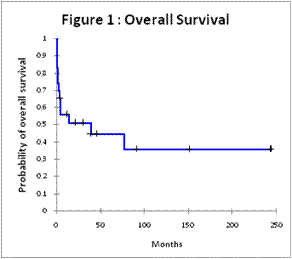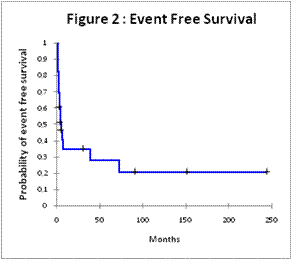Abstract
Background: Peripheral T-cell lymphoma represents a heterogeneous group of mature T/NK lymphoma with an aggressive presentation course and a poor outcome. Disease history is characterized by a high degree of relapsed or refractory disease and an inferior outcome. Etoposide phosphate (VP16) is a non-specific antineoplastic agent frequently used in combination in oncology since 50 years. The major mechanism of action of etoposide is the inhibition of DNA topoisomerase II involved in the unwinding of the DNA molecule during replication. A recent preclinical study suggests an immunomodulatory effect of etoposide by selectively eliminating activated T cells. Specific efficacy of VP16 in T-cell lymphoma and especially in AITL had not been described.
Methods: We retrospectively analyzed data on adult patients with refractory or relapsed angioimmunoblastic T-cell lymphoma (AITL), anaplastic large cell lymphoma and peripheral T-cell lymphoma not otherwise specified (PTCL-NOS) treated in the university hospital center of Tours (France) by VP16 with or without cyclophosphamide between January 1992 and June 2014. VP16 was administrated orally at 75mg daily continuously or at 100 mg/m² daily for 3 days in 15-day cycles if it was associated with oral cyclophosphamide (150mg/m² daily for 3 days). Treatment was associated with prednisone 60 mg/m²/day. All responses were described according to Cheson criteria (2007). Adverse event were reported according to CTCAE (Common Toxicity Criteria of Adverse Events). Treatment was prescribed until progressive disease, intensive therapy or death, and could be stopped according to clinician appreciation after prolonged remission. Overall survival (OS) and event-free survival (EFS) were estimated since time to initiation of VP16 using the method of Kaplan and Meier. Event was defined as disease progression, death or change of treatment for any cause (toxicity, allograft etc.).
Results: A total of 23 patients were enrolled : 13 AITCL, 2 anaplastic lymphoma (all of them were ALK-negative) and 8 PTCL-NOS. Median age at diagnostic was 57.3 years (range, 31-80) with a male preponderance (14/9). Most patients had B-symptoms (n=14) and advanced stage (n=19) with more than one extranodal site for 10 patients. Lactate deshydrogenase was upper normal value for 14 patients. The median number of prior systemic therapies was two (range, 2 to 4). Five patients received VP16 with cyclophosphamide. The overall response rate (ORR) was 65.2% (15 of 23), including 39.1% complete response (CR) (9 of 23). With a median follow up of 64.8 months (range, 33.7 to 96), the median OS was 39 months (95% IC: 4 months-not reached), and EFS 5 months (95% IC: 3 to 39) (Figure 1 and 2). Median duration of treatment was 15 months (range, 1 to 91). For AITL, the ORR was 69.2% (9 of 13), including 46.2% CR (6 of 13). The median OS was 77 months (95% IC : 5 months-not reached), and EFS 39 months (95% IC : 3-73). One haematological adverse event ≥grade 3 induced end of treatment, none extra-haematological adverse event was reported. Three patients received intensive regimen follow by allogenic stem cells transplantation and two of them (both AITL) after the response obtained with VP16. Progressive disease was the main cause of end of treatment (n=15) and of death (n=9). Patients treated with VP16 and cyclophosphamide had the same outcome than those treated with VP16 alone. For the 9 patients who reached a CR, 7 are still under CR at the end of follow up with median time of response of 67.4 months (range, 3 to 244).
Conclusion: With or without cyclophosphamide, VP16 seems to be an effective and safe treatment for relapsed and refractory PTCL. AITL could have a higher sensibility to VP16 than other subtypes with durable responses. A prospective study should confirm these results, even for patient eligible for transplant program. Finally, orally VP16 can be an effective alternative treatment for unfit patients who cannot be included in clinical studies evaluating novel agents for PTCL.
Survival since time to initiation of VP16 with or without cyclophosphamide (n=23)
Survival since time to initiation of VP16 with or without cyclophosphamide (n=23)
No relevant conflicts of interest to declare.
Author notes
Asterisk with author names denotes non-ASH members.



This feature is available to Subscribers Only
Sign In or Create an Account Close Modal